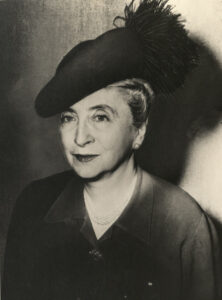Martha Gilmore Robinson
Martha Gilmore Robinson worked in New Orleans for five decades on to improve local government and promote historic preservation.

Courtesy of Louisiana Research Collection at Tulane University Library.
A black and white reproduction of an undated portrait of Martha Gilmore Robinson.
New Orleans native Martha Gilmore Robinson occupied a position of civic prominence in her hometown for five decades. Interested in government reform, she led the Women’s Citizen’s Union and the League of Women Voters. Later in life, she turned her attention to issues of historic preservation, showing a particular interest in French Quarter architecture. In most ways, Robinson was a denizen of her privileged class, working chiefly with women of similarly elite status. On occasion, however, she reached beyond the confines of life on Audubon Place and formed coalitions with a range of women of New Orleans to work for shared goals. Her one foray into elective politics is notable for her attempt to enlist the city’s women to form a female majority, which she hoped to ride to victory in a city-wide race; she ran a campaign which targeted women voters very directly, though unsuccessfully. Ultimately, Robinson became a venerable local institution, the one New Orleans woman whom reporters sought for comment, throughout the mid-twentieth century, when they cared to represent the views of local female civic activists.
Martha Nolan Gilmore was born August 18, 1888, in New Orleans to attorney Samuel Louis Gilmore Sr., and his wife, Martha Frazier Nolan Gilmore. She graduated from Sophie Newcomb College in 1909. Her father’s election to the US Congress followed the next year. Shortly after his sudden death in 1911, Martha married Robert Gibson Robinson, a Princeton graduate and the owner of a prosperous lumber business. Together, they had four sons and a daughter.
In the decade after World War I, Robinson stayed busy founding, acting in, and fund-raising for Le Petit Theatre du Vieux Carre, one of the nation’s earliest small theaters. As her children aged and the demands of motherhood ebbed, Robinson made her first foray into civic affairs by joining her friend Hilda Phelps Hammond’s Women’s Committee of Louisiana to work against Huey P. Long and his supporters. In 1934, she founded the Woman Citizens’ Union, to promote civic activism and voter registration among women. In 1942, that body amalgamated with the League of Women Voters.
During World War II, Robinson served as president of the state League of Women Voters (LWV) and was twice elected president of the New Orleans chapter. Through her efforts, several cities in Louisiana chartered LWV chapters. Her chief goals were the passage of legislation mandating permanent voter registration, civil service, and safe, orderly polls. Successful lobbying and education campaigns by the LWV contributed to adoption of laws requiring all three. In 1954, Robinson unsuccessfully sought to become the first woman on the New Orleans city council. Fearing the consequences of an outspoken, independent critic on the council, Mayor deLesseps “Chep” Morrison worked openly against her candidacy, to the dismay of many women’s organizations. After her defeat in a second primary, Robinson never ran for office again.
Increasingly, she turned her interests to the cause of historic preservation, working through the Louisiana Landmarks Association to block ill-considered development of the French Quarter and to preserve its unique architecture from further destruction. In her late seventies, she was a key figure in the coalition that stymied federal plans for an elevated interstate highway bisecting the French Quarter. Among the awards she won during a long life were the Order of the British Empire (1953), the Times-Picayune Loving Cup (1960), and the Louise DuPont Crowninshield Award from the National Trust for Historic Preservation (1964). She died in February 1981.
